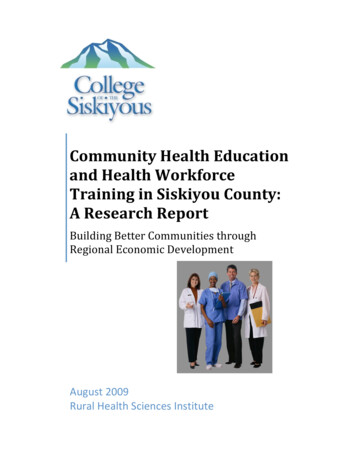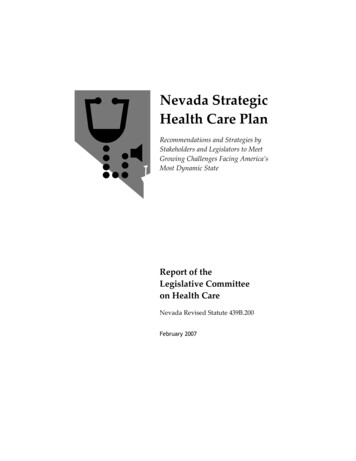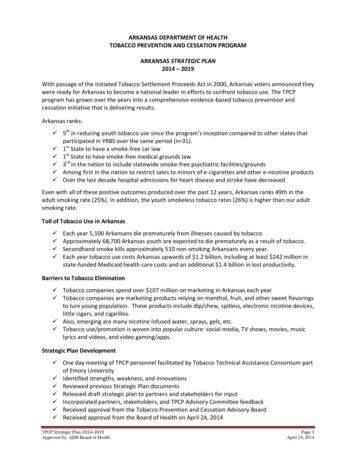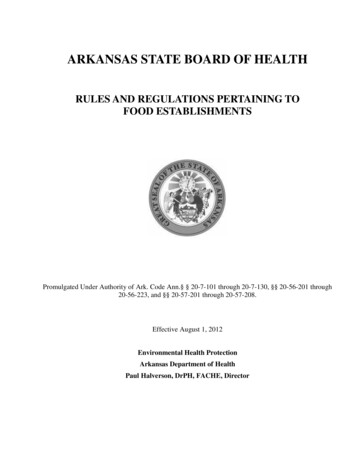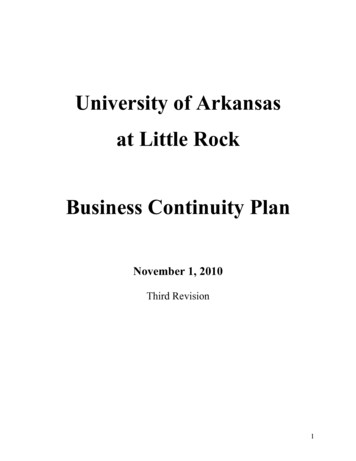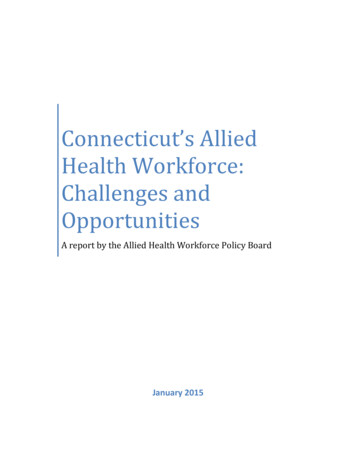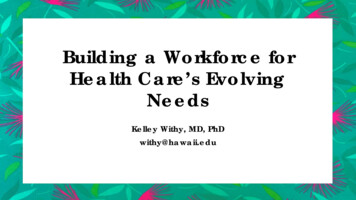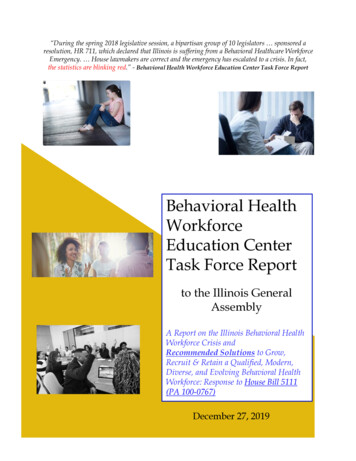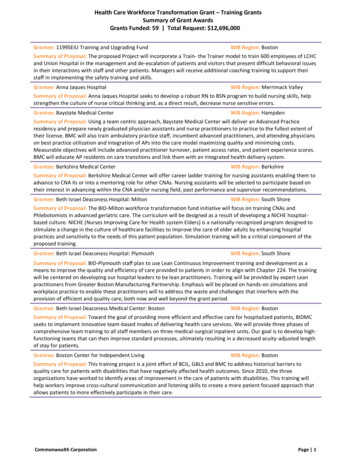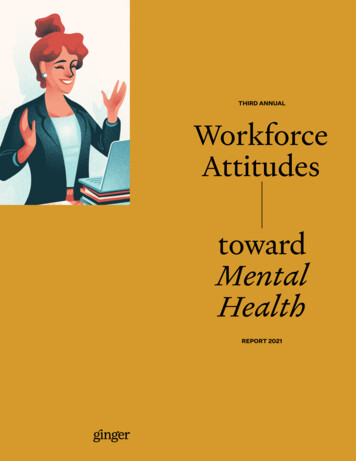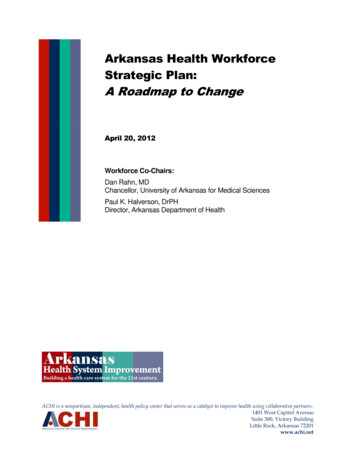
Transcription
Arkansas Health WorkforceStrategic Plan:A Roadmap to ChangeApril 20, 2012Workforce Co-Chairs:Dan Rahn, MDChancellor, University of Arkansas for Medical SciencesPaul K. Halverson, DrPHDirector, Arkansas Department of HealthACHI is a nonpartisan, independent, health policy center that serves as a catalyst to improve health using collaborative partners.1401 West Capitol AvenueSuite 300, Victory BuildingLittle Rock, Arkansas 72201www.achi.net
Table of ContentsList of Abbreviations Used. iiiExecutive Summary. 1Process & Charge .2Goals and Strategies .2Goals & Recommendations . 2Introduction . 6The Problem .6Current Activities .7Ongoing Issues .9Current Health Workforce Supply. 9Estimates of Current Supply . 10Additional Supply and Demand Information . 12Anticipated Challenges & Opportunities .13Population Trends . 13Demographic Trends .13Health Status & Disease Burden .14Socioeconomic Indicators .14Provider Trends. 14Practice Locations and Patterns .14Physician Work and Retirement .15Population Health Improvement.15Lessons Learned from Other States. 16Oregon‘s Medicaid Expansion .16Massachusetts‘ Insurance Coverage Expansion .16Arkansas-Specific Strengths & Opportunities .17The Arkansas Health Workforce Initiative .181. Vision and Mission .182. Key Assumptions .193. Framework and Considerations.194. Focus Areas .20Goals & Recommendations .21Goal 1 . 21Recommendations related to transition to new model.22Recommendations related to educational changes .30Recommendations related to implementation support .32Goal 2 . 35Recommendations related to deployment of health information technology .36Recommendations related to provider and consumer engagement .39Recommendations related to utilization.42Goal 3 . 44Recommendations related to provider education and training .44Recommendations related to provider recruitment.50Recommendations related to provider support .51Goal 4 . 54Recommendations related to payment and reimbursement .54Recommendations related to financial and educational support .58Arkansas Health Workforce Strategic Plan: A Roadmap to Change (4/20/12)Page i
Appendices .61Appendix 1: Health Professional Shortage Areas in Arkansas. 61Appendix 2: Arkansas Health Workforce Initiative Workgroup and Staff . 64Workgroup Members .64Workgroup Staff .64Appendix 3: Arkansas Health Workforce Initiative Stakeholders . 65Appendix 4: Arkansas‘s Challenges—Disease Burden, Risk Factors, Resources. 68Appendix 5: Health Provider Supply in Arkansas. 71Number of Family Practice, General Practice, and Internal Medicine Physicians by County .71Number of Pediatric Physicians by County .72Number of Geriatric Physicians by County.73Number of Obstetric and Gynecologic Physicians by County .74Number of Specialist Physicians by County .75Appendix 6: Agency for Healthcare Research and Quality (AHRQ)Definition of the Medical Home . 76Appendix 7: Care Coordination Programs with the Strongest Evidence of Reductionsin Hospitalizations and Costs for Patients with Chronic Illnesses . 77References.79Arkansas Health Workforce Strategic Plan: A Roadmap to Change (4/20/12)Page ii
List of Abbreviations MHPMPMRNRVUArkansas Association of Two-Year CollegesArkansas Children‘s HospitalArkansas Center for Health ImprovementArkansas Department of EducationArkansas Department of HealthArkansas Department of Higher EducationArkansas Foundation for Medical CareArea Health Education CenterArkansas Medical SocietyAdvanced Nurse PractitionerAll-Payer Claims DatabaseAdvanced Practice NurseArkansas Research and Education and Optical NetworkArkansas Nurses AssociationArkansas Rural Nursing Education ConsortiumArkansas State UniversityUnited States Bureau of Labor StatisticsCenters for Disease Control and Preventioncollaborative drug therapy managementCommunity Health Centers of Arkansas, Inc.Community Health WorkerClinical Nurse Specialistcomprehensive primary careArkansas Department of Human ServicesArkansas Department of Workforce Serviceselectronic medical recordfull-time equivalentgraduate medical educationgeographic practice cost indicesHealth Data Initiativehealth information technologyHealth Professional Shortage Areainternational medical graduateLicensed Practical NurseMedical AssistantMedical Doctormobile health unitNational Commission on Prevention PrioritiesNational Health Service CorpsNational Park Community CollegeArkansas Office of Health Information TechnologyPhysician Assistantpatient-centered medical homeper member per monthRegistered Nurserelative value unitArkansas Health Workforce Strategic Plan: A Roadmap to Change (4/20/12)Page iii
SHARESTEMTBCUALRUAMSUCAUNMUSMGUSPSTFState Health Alliance for Records Exchangescience, technology, engineering, and mathteam-based careUniversity of Arkansas at Little RockUniversity of Arkansas for Medical SciencesUniversity of Central ArkansasUniversity of New MexicoUnited States medical graduateUnited States Preventive Services Task ForceArkansas Health Workforce Strategic Plan: A Roadmap to Change (4/20/12)Page iv
Executive SummaryAt present, Arkansas, like other states, is faced with shortages and geographic maldistribution ofphysicians, nurses, and other health care providers.In the United States, over 58 million people live in areas designated as primary care health professionalshortage areas (HPSAs),1 including over 500,000 Arkansans. HPSAs are areas designated by the HealthResources and Services Administration as having shortages of primary medical care, dental, or mentalhealth providers. Thirty-six entire Arkansas counties are designated as primary care HPSAs, representingalmost half of the counties in the state. There are also 20 counties designated as dental HPSAs and 69 ofthe 75 counties in Arkansas are designated as mental health HPSAs.1 See Appendix 1 for maps of allArkansas HPSAs.Arkansans living in these shortage areas are likely to have difficulty accessing services to address theirhealth care needs. Given the number of shortage areas, many factors are likely to place additional strain onthe system in the future, including the following. Aging population: Arkansas currently has one of the oldest populations in country, and that trend iscontinuing. Given that health needs of populations increase with age and that providers continueto retire from the workforce as they age, this factor is significant. Limited pipeline: The ability of the state‘s educational institutions to educate and train increasingnumbers of health providers is limited and is unlikely to change substantially in the near future. Increased disease burden: Arkansas faces some of the highest rates of hypertension, obesity, anddiabetes in the country, placing a significant burden on the health care system. Half of adultArkansans over the age of 60 have hypertension, of which 40% is uncontrolled.2 Hypertension isa pathway to heart disease, stroke, and kidney failure. Additionally, populations with other diseasesand significant comorbidities create a synergistic impact on demand at the same time that they seereduced quality of life and productivity. More insured citizens: Pursuant to the Patient Protection and Affordable Care Act, almost all of the545,0003 Arkansans who are currently uninsured will be mandated to have health insurance, andthe vast majority will become eligible either for Medicaid or for subsidies to purchase healthinsurance. Despite best efforts, not all Arkansans will become insured. However the estimated328,0003 newly insured people will place additional strain on the workforce. People who areinsured use the health system more frequently than the uninsured, and initial need may be highdue to pent up demand from people who have been uninsured. Health literacy: Health literacy is a person‘s ability to gain access to, understand, and useinformation in ways that promote and maintain good health.4 Among Arkansas adults, 20%read at or below a 5th-grade level, which impacts their ability to understand written information.5Low health literacy and poor health outcomes are strongly related based on factors such asemergency department use, hospitalization, self-reported physical health, and mortality rates.6Each of these issues alone has the potential to place additional burdens on the health workforce. In theaggregate, it is likely they will significantly challenge an already-strained system unless changes are madequickly and decisively to restructure and modernize the staffing and delivery of health care in our state andcountry.Arkansas Health Workforce Strategic Plan: A Roadmap to Change (4/20/12)Page 1
By accomplishing changes in the health care system, the state‘s population can, however, attain betterhealth and higher levels of productivity, which will benefit the state in quality of life for its citizens and ineconomic terms.Process & ChargeTo address the growing challenges that the health workforce will face in the immediate and long-termfuture, Governor Mike Beebe requested that the Arkansas Center for Health Improvement provideprimary staffing to the Arkansas Health Workforce Initiative. The Arkansas Health Workforce Initiative’s coreworkgroup is co-chaired by Dr. Dan Rahn, Chancellor, University of Arkansas for Medical Sciences, andDr. Paul Halverson, State Health Director, Arkansas Department of Health. The Arkansas HealthWorkforce Initiative also includes representatives from numerous health and workforce-related entitiesthroughout the state who serve as members of the workgroup and a larger stakeholder forum (seeAppendices 2 and 3). The purpose of the Arkansas Health Workforce Initiative is to develop andcommunicate a transformational strategic plan for the Arkansas health workforce.Goals and StrategiesThe Arkansas Health Workforce Strategic Plan is intended to be the first step in a larger commitment toensure that the health workforce in our state will meet the present and future health and health care needsof Arkansans. This plan is to be a roadmap to change that includes specific recommendations to improvenavigation and coordination through team-based care, expand the availability and use of technology,increase the supply of and address the maldistribution of available providers, and adjust the paymentsystem to support these changes. Each of the four overall goals is addressed by multiple specificrecommendations.Goals & RecommendationsGoal 1: Support the implementation of and transition to team-based care that ispatient-centered, coordinated, evidence-based, and efficientRecommendations related to transition to new model1-1. Define team-based care (TBC) across various types of care sites. Identify team members, corecompetencies, practice roles, training needs, and outcome metrics for care teams, including carecoordinators and non-traditional providers in primary care settings, while assuring that patientsafety and quality of care are protected in the assignment of clinical roles on the team. Adoptevidence-based guidelines for TBC, including evaluation protocols.1-2. Deploy population-based management strategies into primary care delivery systems.1-3. Optimize the use of non-physician providers and staff to advance evidence-based care andpreventive patient management.1-4. Assure access to counseling for behavioral change in primary care settings.1-5. Develop and support community reinforcement mechanisms such as community health workers,direct care workers, and faith-based initiatives.1-6. Integrate culturally competent health literacy programs for providers and patients to promote andsupport patient self-management in all health care settings.1-7. Incorporate patient participation in delivery system evaluations.Arkansas Health Workforce Strategic Plan: A Roadmap to Change (4/20/12)Page 2
1-8. Utilize pharmacists as part of the care team for collaborative drug therapy management.1-9. Organize mass health clinics for health assessments, preventive screenings and services, publicand private health insurance enrollment, and eligibility for insurance exchange products andsubsidies.Recommendations related to educational changes1-10. Integrate inter-professional collaboration training into the health educatio
ARNEC Arkansas Rural Nursing Education Consortium ASU Arkansas State University . UALR University of Arkansas at Little Rock . Establish education, training, and certification programs, including career ladder training, for care coordinators, and develop and train care coordinators to be incorporated into care teams. .
